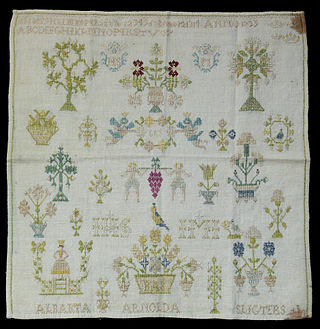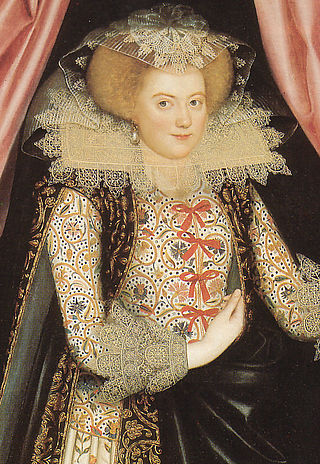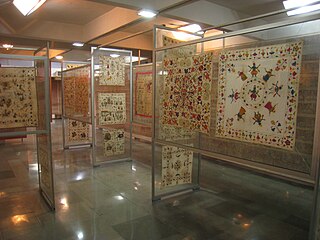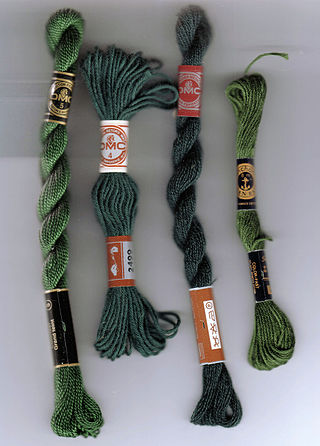
Cross-stitch is a form of sewing and a popular form of counted-thread embroidery in which X-shaped stitches in a tiled, raster-like pattern are used to form a picture. The stitcher counts the threads on a piece of evenweave fabric in each direction so that the stitches are of uniform size and appearance. This form of cross-stitch is also called counted cross-stitch in order to distinguish it from other forms of cross-stitch. Sometimes cross-stitch is done on designs printed on the fabric ; the stitcher simply stitches over the printed pattern. Cross-stitch is often executed on easily countable fabric called aida cloth whose weave creates a plainly visible grid of squares with holes for the needle at each corner.

Embroidery is the craft of decorating fabric or other materials using a needle to apply thread or yarn. Embroidery may also incorporate other materials such as pearls, beads, quills, and sequins. In modern days, embroidery is usually seen on caps, hats, coats, overlays, blankets, dress shirts, denim, dresses, stockings, scarfs, and golf shirts. Embroidery is available in a wide variety of thread or yarn colour. It is often used to personalize gifts or clothing items.

Blackwork, sometimes historically termed Spanish blackwork, is a form of embroidery generally worked in black thread, although other colours are also used on occasion, as in scarletwork, where the embroidery is worked in red thread. Originating in Tudor period England, blackwork typically, though not always, takes the form of a counted-thread embroidery, where the warp and weft yarns of a fabric are counted for the length of each stitch, producing uniform-length stitches and a precise pattern on an even-weave fabric. Blackwork may also take the form of free-stitch embroidery, where the yarns of a fabric are not counted while sewing.

Crewel embroidery, or crewelwork, is a type of surface embroidery using wool. A wide variety of different embroidery stitches are used to follow a design outline applied to the fabric. The technique is at least a thousand years old.
Needlepoint is a type of canvas work, a form of embroidery in which yarn is stitched through a stiff open weave canvas. Traditionally needlepoint designs completely cover the canvas. Although needlepoint may be worked in a variety of stitches, many needlepoint designs use only a simple tent stitch and rely upon color changes in the yarn to construct the pattern. Needlepoint is the oldest form of canvas work.

Chain stitch is a sewing and embroidery technique in which a series of looped stitches form a chain-like pattern. Chain stitch is an ancient craft – examples of surviving Chinese chain stitch embroidery worked in silk thread have been dated to the Warring States period. Handmade chain stitch embroidery does not require that the needle pass through more than one layer of fabric. For this reason the stitch is an effective surface embellishment near seams on finished fabric. Because chain stitches can form flowing, curved lines, they are used in many surface embroidery styles that mimic "drawing" in thread.

Jacobean embroidery refers to embroidery styles that flourished in the reign of King James I of England in first quarter of the 17th century.

Stumpwork or raised work is a style of embroidery in which the stitched figures are raised from the surface of the work to form a 3-dimensional effect.

Chikankari is a traditional embroidery style from Lucknow, India. Translated, the word means embroidery, and it is one of Lucknow's best known textile decoration styles. The main market in Lucknow for Chikankari based products is Chowk. Production is mainly based in Lucknow and in the adjoining districts.
Surface embroidery is any form of embroidery in which the pattern is worked by the use of decorative stitches and laid threads on top of the foundation fabric or canvas rather than through the fabric; it is contrasted with canvas work.

Embroidery in India includes dozens of embroidery styles that vary by region and clothing styles. Designs in Indian embroidery are formed on the basis of the texture and the design of the fabric and the stitch. The dot and the alternate dot, the circle, the square, the triangle, and permutations and combinations of these constitute the design.
The manufacture of textiles is one of the oldest of human technologies. To make textiles, the first requirement is a source of fiber from which a yarn can be made, primarily by spinning. The yarn is processed by knitting or weaving, which turns yarn into cloth. The machine used for weaving is the loom. For decoration, the process of colouring yarn or the finished material is dyeing. For more information of the various steps, see textile manufacturing.

Smocking is an embroidery technique used to gather fabric so that it can stretch. Before elastic, smocking was commonly used in cuffs, bodices, and necklines in garments where buttons were undesirable. Smocking developed in England and has been practised since the Middle Ages and is unusual among embroidery methods in that it was often worn by labourers. Other major embroidery styles are purely decorative and represented status symbols. Smocking was practical for garments to be both form fitting and flexible, hence its name derives from smock — an agricultural labourer's work shirt. Smocking was used most extensively in the eighteenth and nineteenth centuries.

In embroidery, couching and laid work are techniques in which yarn or other materials are laid across the surface of the ground fabric and fastened in place with small stitches of the same or a different yarn.

Embroidery thread is yarn that is manufactured or hand-spun specifically for embroidery and other forms of needlework. Embroidery thread often differs widely, coming in many different fiber types, colors and weights.

Cross stitches in embroidery, needlepoint, and other forms of needlework include a number of related stitches in which the thread is sewn in an x or + shape. Cross stitch has been called "probably the most widely used stitch of all" and is part of the needlework traditions of the Balkans, Middle East, Afghanistan, Colonial America and Victorian England.

In needlework, a slip is a design representing a cutting or specimen of a plant, usually with flowers or fruit and leaves on a stem. Most often, slip refers to a plant design stitched in canvaswork (pettipoint), cut out, and applied to a woven background fabric. By extension, slip may also mean any embroidered or canvaswork motif, floral or not, mounted to fabric in this way.

English embroidery includes embroidery worked in England or by English people abroad from Anglo-Saxon times to the present day. The oldest surviving English embroideries include items from the early 10th century preserved in Durham Cathedral and the 11th century Bayeux Tapestry, if it was worked in England. The professional workshops of Medieval England created rich embroidery in metal thread and silk for ecclesiastical and secular uses. This style was called Opus Anglicanum or "English work", and was famous throughout Europe.
Sewing is the craft of fastening or attaching objects using stitches made with needle and thread. Sewing is one of the oldest of the textile arts, arising in the Paleolithic Era. Although usually associated with clothing and household linens, sewing is used in a variety of crafts and industries, including shoemaking, upholstery, sailmaking, bookbinding and the manufacturing of some kinds of sporting goods. Sewing is the fundamental process underlying a variety of textile arts and crafts, including embroidery, tapestry, quilting, appliqué and patchwork.
Bed hangings or bed curtains are fabric panels that surround a bed; they were used from medieval times through to the 19th century. Bed hangings provided privacy when the master or great bed was in a public room, such as the parlor. They also kept warmth in, and were a way of showing one's wealth. When bedrooms became more common in the mid-1700s, the use of bed hangings diminished.


















